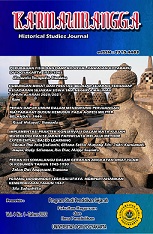Peran Dapur Umum dalam Mendukung Perjuangan Masyarakat Dusun Kemusuk Pada Agresi Militer Belanda II 1949
DOI:
https://doi.org/10.31316/2021Keywords:
Common Kitchen, Dutch Military Aggression II, RoleAbstract
ABSTRACT
The purpose of this study is to find out: (1) The Role of Public Kitchens during Dutch Military Aggression II (2) Factors of organizing Public Kitchens during Dutch Military Aggression II (3) Constraints in the implementation of Public Kitchens during Dutch Military Aggression II (4) The impact of the implementation of Public Kitchens during Dutch Military Aggression II.
The method used in this study is qualitative research method. This research has two types of data and data sources, namely primary data, data obtained through direct interviews and secondary data, data in the form of journals and books. Data collection techniques by conducting live observations, in-depth interviews, and documentation. Data analysis techniques are used by data collection, data reduction, data presentation and conclusion drawing. The techniques of checking the validity of the data used are source trianggulation techniques and theoretical trianggulation.
The results of this study show that: (1) The role of the Common Kitchen to meet the food of soldiers and civillian, the headquarters of military, emergency hospital. (2) The organizing factor of the Public Kitchen is due to the scarcity of foodstuffs due to aggression and the number of refugees. (3) The constraints of the implementation of the Public Kitchen are the scarcity of foodstuffs and the presence of Dutch spies. (4) The impact of the implementation of the Public Kitchen is that logistics needs are met, there is a sense of security in the civilian, and the establishment of village security agency.
Keywords: Common Kitchen, Dutch Military Aggression II, Role
References
Akbar, Allan. 2018. Kawan atau Lawan? Tuduhan Mata-mata Belanda pada Masa Revolusi 1945-1949. Jurnal Sejarah, 2 (1) , 30 – 42. DOI: https://doi.org/10.26639/js.v2i1.115
Ali, Muhammad. 1985. Penelitian Kependidikan: Prosedur dan Strategi. Bandung: Angkasa.
Baha Uddin, dkk. 2020. Masyarakat Pedesaan dan Revolusi Kemerdekaan di Yogyakarta. Yogyakarta: Dinas Kebudayaan DIY.
Ibrahim, Julianto. 2014. Dinamika Sosial dan Politik Masa Revolusi Indonesia. Yogyakarta: Gadjah Mada Press.
Ibrahim, Julianto. 2014. Diplomat Awal Republik Indonesia 1945-1949: Antara Sipil dan Militer. Yogyakarta: Universitas Gajah Mada.
Juyoto, Djujuk dkk. 1991. Gemuruh Kemusuk. Jakarta: Proyeksi Utama.
Moleong, Lexy J. 2012. Metodologi Penelitian Kualitatif. Bandung: PT. Remaja Rosdakarya.
Nasution, A.H. 1984. Pokok-Pokok Gerilya. Bandung: Angkasa
Nusferadi, Adi. 2008. Konteks Internasional Pasca Perang Dunia II dan Langkah Awal Perjuangan Diplomasi RI. Jurnal Sejarah Lontar, 5 (1), 12. DOI: https://doi.org/10.21009/LONTAR.051
SESKOAD. 1993. Serangan Umum 1 Maret di Yogyakarta: Latar Belakang dan Pengaruhnya. Jakarta: Citra Lamtoro Gung Persada.
Sri Margana, dkk. 2017. Gelora di Tanah Raja: Yogyakarta Pada Masa Revolusi. Yogyakarta: Dinas Kebudayaan DIY.
Suhartono, dkk. 2002. Yogyakarta Ibukota Republik Indonesia 4 Januari 1946-27 Desember 1949. Yogyakarta: Kanisius.
Suhatno. 2006. Sumbangan Wanita Yogyakarta pada Masa Revolusi. Jurnal Jantra. 1 (2), 67. Link: https://kebudayaan.kemdikbud.go.id/bpnbyogyakarta/jurnal-jantra-vol-1-no-2-desember-2006/
Susilo, Agus. 2018. Sejarah Perjuangan Jenderal Soedirman dalam Mempertahankan Indonesia (1945-1950). Jurnal Historia. 6 (1), 65-66. DOI: http://dx.doi.org/10.24127/hj.v6i1.1149
Thiam Tjing, Kwee. 2010. Menjadi Tjamboek Berdoeri: Memoar Kwee Thiam Tjing. Depok: Komunitas Bambu.
Triwahyono, Tugas. 2011. Pasukan Gerilya Desa (Pager Desa) Peranannya Pada Masa Revolusi Tahun 1949-1950 di Colomadu, Karanganyar. Jurnal Patra Widya. 12 (1), 14. Link: https://unsla-dev.uns.ac.id/neounsla/index.php?p=show_detail&id=34981&keywords=
Downloads
Published
How to Cite
Issue
Section
License
Authors who publish with this journal agree to the following terms:
- The journal allow the authors to hold the copyright without restrictions and allow the authors to retain publishing rights without restrictions.
- Authors retain copyright and grant the journal right of first publication with the work simultaneously licensed under a Creative Commons Attribution-ShareAlike 4.0 International License that allows others to share the work with an acknowledgement of the work's authorship and initial publication in this journal.
- Authors are able to enter into separate, additional contractual arrangements for the non-exclusive distribution of the journal's published version of the work (e.g., post it to an institutional repository or publish it in a book), with an acknowledgement of its initial publication in this journal.
- Authors are permitted and encouraged to post their work online (e.g., in institutional repositories or on their website) prior to and during the submission process, as it can lead to productive exchanges, as well as earlier and greater citation of published work (See The Effect of Open Access).
Â

The work is distributed under Lisensi Creative Commons Atribusi-BerbagiSerupa 4.0 Internasional.








